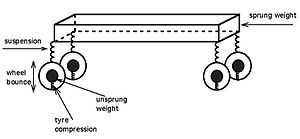1)Dependent
Suspension - It is a type of suspension in which left and right suspension are
linked together and disturbance on one side is transferred to other side.
Independent
Suspension -
It is a type of suspension in which left and right suspension are not
linked together
and disturbance on one side is not transferred
to other side.
Independent suspension is classified into
1).MacPherson Strut
2).Double Wishbone
1).MacPherson Strut: The MacPherson strut combines a shock absorber and a coil spring into a single
unit. This provides a more compact and lighter suspension system that can be
used for front-wheel drive vehicles.
2).Double Wishbone:This is classified into
a) COIL SPRING TYPE 1:
This is a type of double-A or double wishbone suspension. The wheel spindles are supported by an upper and lower 'A' shaped arm.In this type, the lower arm carries most of the load. If you look head-on at this type of system, what you'll find is that it's a very parallelogram system that allows the spindles to travel vertically up and down. When they do this, they also have a slight side-to-side motion caused by the arc that the wishbones describe around their pivot points. This side-to-side motion is known as scrub.Unless the links are infinitely long the scrub motion is always present. There are two other types of motion of the wheel relative to the body when the suspension articulates.
b) COIL SPRING TYPE 2:This is also a type of double-A arm suspension although the lower arm in these systems can sometimes be replaced with a single solid arm . The only real difference between this and the previous system mentioned above is that the spring/shock combo is moved from between the arms to above the upper arm. This transfers the load-bearing capability of the suspension almost entirely to the upper arm and the spring mounts. The lower arm in this instance becomes a control arm
c)Multi link suspension:The basic principle of it is the same, but instead of solid upper and lower wishbones, each 'arm' of the wishbone is a separate item. These are joined at the top and bottom of the spindle thus forming the wishbone shape. The super-weird thing about this is that as the spindle turns for steering, it alters the geometry of the suspension by torquing all four suspension arms.
There are a lot of variations on this theme appearing at the moment, with huge differences in the numbers and complexities of joints, numbers of arms, positioning of the parts etc. but they are all fundamentally the same.
d)trailing arm suspension:The trailing arm system is literally that - a shaped suspension arm is joined at the front to the chassis, allowing the rear to swing up and down. Pairs of these become twin-trailing-arm systems and work on exactly the same principle as the double wishbones in the systems described above. The difference is that instead of the arms sticking out from the side of the chassis, they travel back parallel to it. This is an older system not used so much any more because of the space it takes up.
e)twin I beam suspension:This is a combination of trailing arm suspension and solid beam axle suspension. Only in this case the beam is split in two and mounted offset from the centre of the chassis, one section for each side of the suspension. The trailing arms are actually (technically) leading arms and the steering gear is mounted in front of the suspension setup.
ref:www.carbible.com












.jpg)

